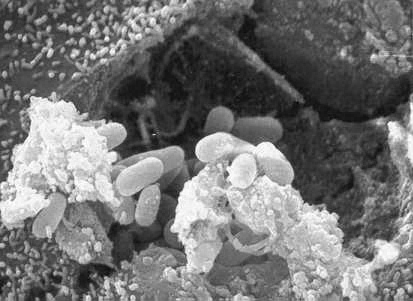Encephalitozoon hellem: Difference between revisions
No edit summary |
|||
| Line 31: | Line 31: | ||
==Pathology== | ==Pathology== | ||
E. hellem was first isloated in an HIV patient, but has also been found to infect mice, birds, and even bats. When isolating | <i>E. hellem</i> was first isloated in an HIV patient, but has also been found to infect mice, birds, and even bats. When isolating <i>E. hellem</i> in the HIV patient, there were 24 monoclonal antibodies that were used against not only <i>E. hellem</i>, but also two other species of Encephalitozoon, E. intestinalis and E. cuniculi. The antibodies did not react with either of these two, indicating antibody specificity across the three species. Antigenic diversity of the different karyotypes of <i>E. hellem</i> was demonstrated as well when two monoclonal antibodies reacted with one karyotype and not the other. | ||
==Application to Biotechnology== | ==Application to Biotechnology== | ||
Revision as of 02:39, 24 August 2007
A Microbial Biorealm page on the genus Encephalitozoon hellem

Classification
Higher order taxa
Superkingdom, Kingdom, Phylum, Suborder, Family, Genus:
Eukaryota, Fungi, Microsporidia, Apansporoblastina, Unikaryonidae, Encephalitozoon
Species
Encephalitozoon hellem
Description and significance
Describe the appearance, habitat, etc. of the organism, and why it is important enough to have its genome sequenced. Describe how and where it was isolated. Include a picture or two (with sources) if you can find them.
Genome structure
Describe the size and content of the genome. How many chromosomes? Circular or linear? Other interesting features? What is known about its sequence? Does it have any plasmids? Are they important to the organism's lifestyle?
Cell structure and metabolism
Describe any interesting features and/or cell structures; how it gains energy; what important molecules it produces. Encephalitozoon hellem is a unicellular, intracellular microsporidian species (1)
Ecology
Describe any interactions with other organisms (included eukaryotes), contributions to the environment, effect on environment, etc.
Pathology
E. hellem was first isloated in an HIV patient, but has also been found to infect mice, birds, and even bats. When isolating E. hellem in the HIV patient, there were 24 monoclonal antibodies that were used against not only E. hellem, but also two other species of Encephalitozoon, E. intestinalis and E. cuniculi. The antibodies did not react with either of these two, indicating antibody specificity across the three species. Antigenic diversity of the different karyotypes of E. hellem was demonstrated as well when two monoclonal antibodies reacted with one karyotype and not the other.
Application to Biotechnology
Does this organism produce any useful compounds or enzymes? What are they and how are they used?
Current Research
Enter summaries of the most recent research here--at least three required
References
Edited by student of Rachel Larsen
